Kuniyoshi Utagawa, a name that resonates with vibrancy in the annals of Japanese art history, was a visionary ukiyo-e artist whose works transcended the boundaries of mere visual appeal to narrate stories, embody cultures, and evoke emotions. His journey from a humble apprentice to a master artist is a testament to his relentless dedication, unique style, and profound influence on the ukiyo-e genre.
Early Beginnings and Ukiyo-e Involvement
Born in 1798 in Edo (modern-day Tokyo), Kuniyoshi (originally named Yoshisaburō) was the son of a silk-dyer. From a young age, he exhibited a keen interest in art, inspired by the rich cultural tapestry of his surroundings. His formal entry into the ukiyo-e world began under the tutelage of Utagawa Toyokuni I, a prominent artist of the time. This apprenticeship laid the foundational stone of what would become a monumental career in the arts.
Artistic Evolution and Signature Style
Kuniyoshi’s style evolved significantly over the years, marked by a distinct blend of dynamic compositions, intricate detailing, and vivid storytelling. His early works were influenced by Chinese and Western art, incorporating elements that were unconventional in Japanese prints. He was particularly noted for his adept use of colors, shades, and lines, creating scenes that were lifelike and filled with motion.
Musha-e: The Samurai Prints
One of Kuniyoshi’s most celebrated contributions to ukiyo-e was his Musha-e or samurai prints. These works depicted legendary warriors, historical battles, and heroic tales from Japan’s rich past. Kuniyoshi’s Musha-e stood out for their dramatic expressions, attention to armor details, supernatural elements, and the portrayal of intense battle scenes, which captivated the imagination of his audience.
Two great examples of Musha-e by Kuniyoshi are below. You can also find other warrior prints by Kuniyoshi at the kuniyoshiproject.com
For an indepth look: Samurai in Ukiyo-e and Japanese Art: Guardians of Tradition, Icons of Eternity.
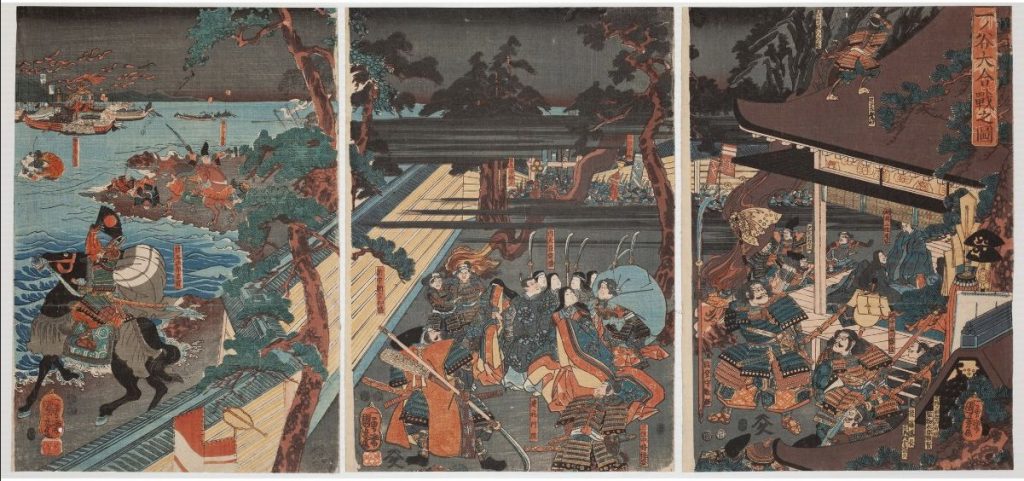
The Battle of Ichinotani by Utagawa Kuniyoshi
This battle was a pivotal conflict in the Genpei War, marking a significant turning point in the struggle between the Minamoto and Taira clans for control over Japan in the late 12th century. This battle demonstrated the Minamoto clan’s strategic prowess and marked the beginning of the decline of the Taira clan, setting the stage for the eventual establishment of the Kamakura shogunate. The victory at Ichinotani significantly influenced the political landscape of medieval Japan, shifting power dynamics and heralding a new era of samurai governance.
Utagawa Kuniyoshi’s artwork depicting the Battle of Ichinotani captures the drama and intensity of this historic clash with dynamic composition and vivid detail. His prints bring to life the heroism and valor of the samurai warriors, showcasing his skill in portraying epic battles and legendary feats, while reflecting the enduring interest in the tales of the Genpei War and its heroes in Japanese culture.
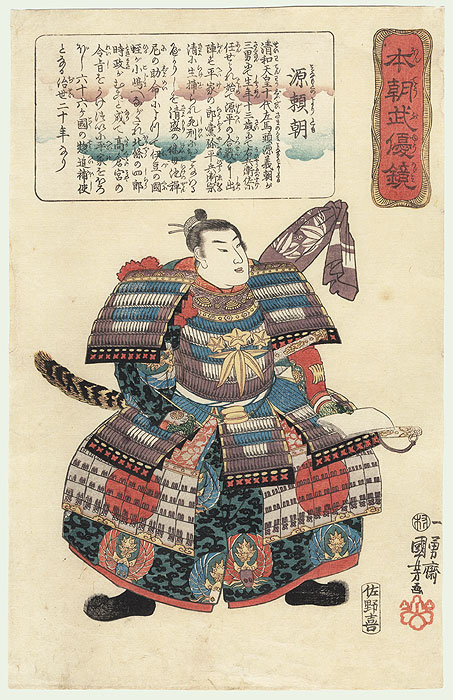
Minamoto no Yoritomo by Utagawa Kuniyoshi
The Samurai know as Minamoto no Yoritomo was the founder and first shogun of the Kamakura Shogunate, establishing the first samurai-led government in Japan at the end of the 12th century. His leadership marked the beginning of the shogunate system that would dominate Japanese politics for the next seven centuries, significantly altering the country’s governance structure. Yoritomo’s rise to power after winning the Genpei War against the Taira clan laid the foundation for feudal Japan, emphasizing the role of the samurai class and military governance.
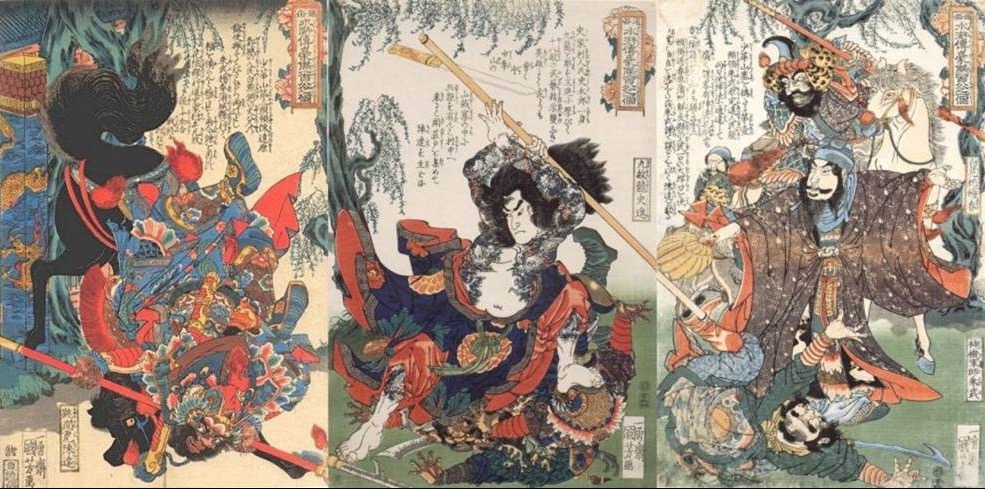
Iconic Works and Innovations: The 108 Heroes of the Popular Suikoden
Among Kuniyoshi’s vast portfolio, certain works stand out for their artistic and cultural significance. “The 108 Heroes of the Popular Suikoden” is one such series that catapulted him to fame.
This series, made in the 1820s, is based on the Chinese novel “Shui Hu Zhuan” (Water Margin), which tells the stories of 108 outlaws who, bound by fate and shared injustice, band together to form a formidable bandit gang on Mount Liang. Kuniyoshi’s dynamic and vivid portrayal of these characters, with a strong emphasis on their heroic qualities, individual personalities, and fantastical feats, captured the imagination of the Japanese public. His work not only revitalized the ukiyo-e genre but also significantly influenced the depiction of historical and mythical figures in Japanese art, showcasing his mastery in blending narrative depth with artistic beauty.
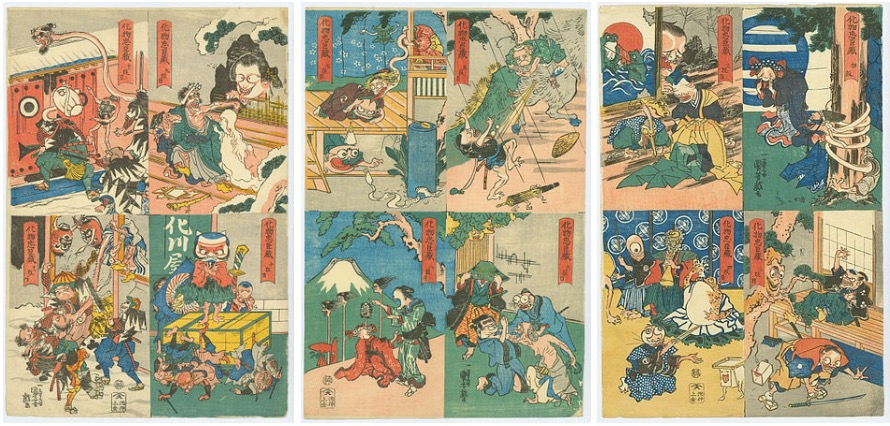
Chūshingura and Kuniyoshi
Chūshingura recounts forty-seven ronin avenging their lord, Asano Naganori. They meticulously plotted against Kira Yoshinaka. After their revenge, they turned themselves in. They died by seppuku, upholding the samurai honor code. The tale has been celebrated in various forms of Japanese art and culture, illustrating themes of loyalty, sacrifice, and honor. The graves of these ronin at Sengaku-ji Temple in Tokyo remain a symbol of their enduring legacy.
Kuniyoshi famously depicted scenes from Chūshingura, bringing to life the dramatic intensity and emotional depth of the story. His art shows Chūshingura’s key moments with vivid, expressive detail. Kuniyoshi’s prints, known for dynamic scenes and rich stories, helped make the tale popular in Edo Japan.
Impact and Legacy
Kuniyoshi’s influence on the development of Japanese art extends beyond his vibrant depictions of historical narratives and legendary tales. Kuniyoshi, a pivotal figure in Ukiyo-e, introduced styles and techniques that captivated many. His work set the stage for future art exploration. Yoshitoshi Tsukioka, seen as his successor, expanded on Kuniyoshi’s storytelling and visuals. He extended Ukiyo-e’s reach into the Meiji era and further. Kuniyoshi’s global impact is clear, with his art featured worldwide. Exhibitions celebrate his artistic contributions. They showcase his talent’s range and impact on Japanese art’s global view. Kuniyoshi linked traditional Japanese art with the world.
Challenges and Government Censorship
Kuniyoshi’s career was not without challenges. Early in his career as an independent ukiyo-e artist, he had minimal success, supplementing his income by selling tatami mats. His life changed in 1827 however, with the publication of 108 Heroes of the Suikoden, when there was significant public demand for Musha-e.
Kuniyoshi faced mass censorship when the Tenpō Reforms of 1841–1843 banned the ukiyo-e depictions of courtesans and kabuki actors. His works, especially those with political undertones, often attracted government scrutiny. Despite such hurdles, he continued to produce art that resonated with the masses, subtly incorporating his views and critiques.
Conclusion: A Legacy That Lives On
Kuniyoshi Utagawa’s journey from an aspiring artist to a master of ukiyo-e and Musha-e is a narrative of perseverance, innovation, and artistic excellence. His legacy continues to inspire and enchant, making him an enduring figure in the world of Japanese art.
Frequently Asked Questions on Kuniyoshi Utagawa
What is Ukiyo-e?
Ukiyo-e is a genre of Japanese art that flourished from the 17th through the 19th centuries. It involves woodblock prints and paintings that depict everyday life, landscapes, and historical tales.
Who was Kuniyoshi Utagawa?
Kuniyoshi Utagawa was a celebrated Japanese ukiyo-e artist known for his detailed prints of samurai, landscapes, and folklore. He lived during the late Edo period and was a significant figure in the Utagawa school.
What makes Kuniyoshi’s Musha-e unique?
Kuniyoshi’s Musha-e or samurai prints are renowned for their dynamic portrayal of legendary warriors, attention to historical accuracy in armor and weapons, and the vivid depiction of battles, setting them apart in the genre of ukiyo-e.
How did Kuniyoshi influence Japanese art?
Kuniyoshi’s innovative techniques, unique style, and thematic diversity influenced not only his contemporaries but also future generations of artists. His work helped elevate the status of ukiyo-e and contributed to its popularity both in Japan and internationally.
Where can one see Kuniyoshi’s works today?
Kuniyoshi’s works are held in numerous museums and collections worldwide, including the British Museum in London, the Metropolitan Museum of Art in New York, and the Ukiyo-e Ota Memorial Museum of Art in Tokyo.
Read more:
- Collecting Ukiyo-e Art: A Guide for Beginners
- 11 Most Influential Ukiyo-e Artists: Masters of Japanese Woodblock Prints
- The 12 Most Important Ukiyo-e Artworks of All Time
- The Symbolism of Wildly Popular Japanese Woodblock Art
- Art, Mind, and Soul: The Transformative Power of Japanese Ukiyo-e
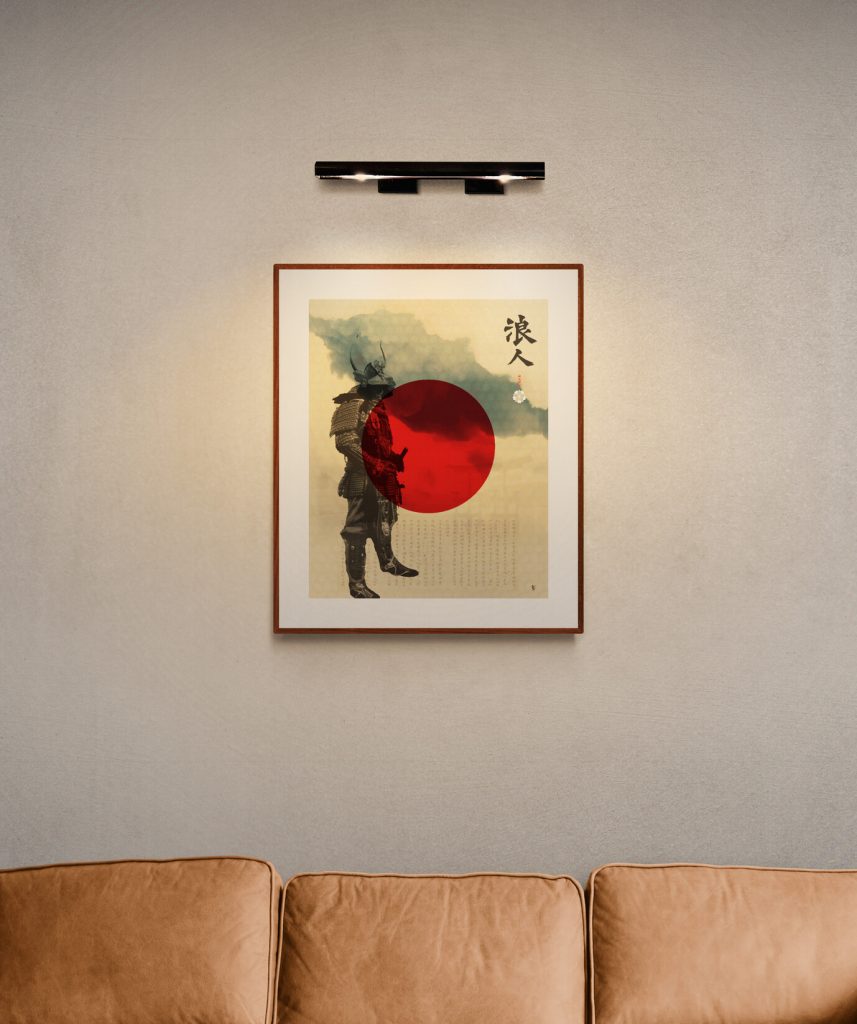
At the Art of Zen we have a selection of original Japanese art prints in the ukiyo-e and Japandi style. Some of our best selling work is Mount Fuji wall art and Japandi wall art.
Add some zen to your space with brilliant original art from the Art of Zen shop.
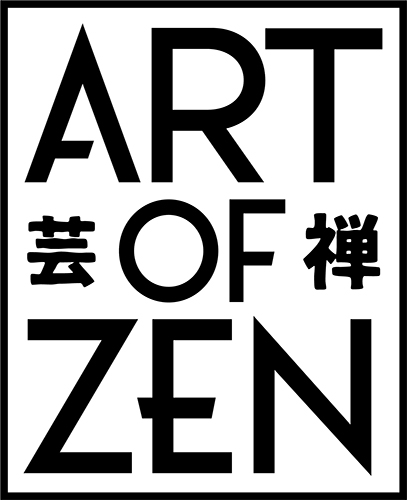

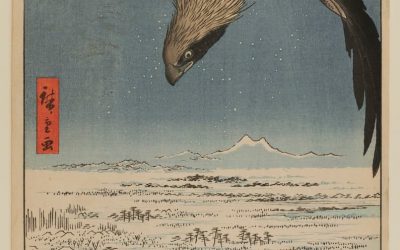

0 Comments